Sensory Preference and Professional Profile Affinity Definition of Endangered Native Breed Eggs Compared to Commercial Laying Lineages’ Eggs
Simple Summary
Abstract
1. Introduction
2. Materials and Methods
2.1. Free-Choice Profiling (FCP)
2.1.1. Professional Panel Description
2.1.2. Sampling
2.1.3. Evaluation Sessions
2.1.4. Sensory Evaluation and Panelist Contextual Records
2.2. Free-Choice Profiling Interobserver Correlation Coefficient (ICC)
2.3. Scale Reliability
2.4. Quantitative Descriptive Analysis (QDA)
2.5. Egg Type Sensory Attributes Difference Analysis
2.6. Statistical Justification
2.7. Non-Linear Canonical Correlation between Sets
3. Results
4. Discussion
5. Conclusions
Supplementary Materials
Author Contributions
Funding
Acknowledgments
Conflicts of Interest
References
- Orozco, F. Razas de Gallinas Españolas, 1st ed.; Mundi-Prensa Libros S.A.: Madrid, Spain, 1989; p. 216. [Google Scholar]
- FAOSTAT. (Search Terms: RegionsProduction Quantity; Items>Eggs, hen, in shell (number); Years>2017). Available online: http://www.fao.org/faostat/en/ (accessed on 23 June 2019).
- Blokhuis, H.; Jones, R.; Geers, R.; Miele, M.; Veissier, I. Measuring and monitoring animal welfare: Transparency in the food product quality chain. Anim. Welf. 2003, 12, 445–455. [Google Scholar]
- González Ariza, A.; Navas González, F.J.; Arando Arbulu, A.; León Jurado, J.M.; Barba Capote, C.J.; Camacho Vallejo, M.E. Non-Parametrical Canonical Analysis of Quality-Related Characteristics of Eggs of Different Varieties of Native Hens Compared to Laying Lineage. Animals 2019, 9, 153. [Google Scholar] [CrossRef] [PubMed]
- Alderson, G. Conservation of breeds and maintenance of biodiversity: Justification and methodology for the conservation of Animal Genetic Resources. Archivos de Zootecnia 2018, 65, 300–309. [Google Scholar] [CrossRef]
- Henchion, M.; De Backer, C.; Huders, L. Ethical and sustainable aspects of meat production: Consumer perceptions and system credibility. In New Aspects of Meat Quality, 1st ed.; Purslow, P.P., Ed.; Woodhead Publishing: Sawston, UK, 2017; pp. 649–666. [Google Scholar]
- Washburn, K.W. Genetic Variation in the Chemical Composition of the Egg. Poult. Sci. 1979, 58, 529–535. [Google Scholar] [CrossRef]
- Hanusová, E.; Hrnčár, C.; Hanus, A.; Oravcová, M. Effect of breed on some parameters of egg quality in laying hens. Acta Fytotechnica et Zootechnica 2015, 18, 20–24. [Google Scholar] [CrossRef]
- Williams, A.A.; Arnold, G.M. A Comparison of the Aromas of Six Coffees Characterised by Conventional Profiling, Scaling Methods Free-Choice Profiling and Similarity. J. Sci. Food Agric. 1985, 36, 477–491. [Google Scholar] [CrossRef]
- Bárcenas, P.; Pérez de San Román, R.; Pérez Elortondo, F.J.; Albisu, M. Consumer preference structures for traditional Spanish cheeses and their relationship with sensory properties. Food Qual. Prefer. 2001, 12, 269–279. [Google Scholar] [CrossRef]
- Stone, H.; Sidel, J.; Oliver, S.; Woolsey, A.; Singleton, R.C. Sensory Evaluation By Quantitative Descriptive Analysis. Food Technol. 1974, 52, 23–34. [Google Scholar]
- Grosse Frie, K.; Janssen, C. Social inequality, lifestyles and health—A non-linear canonical correlation analysis based on the approach of Pierre Bourdieu. Int. J. Public Health 2009, 54, 213–221. [Google Scholar] [CrossRef]
- Van der Burg, E.; De Leeuw, J.; Dijksterhuis, G. OVERALS: Nonlinear canonical correlation with k sets of variables. Comput. Stat. Data Anal. 1994, 18, 141–163. [Google Scholar] [CrossRef]
- Hough, G.; Wakeling, I.; Mucci, A.; Chambers, E., IV; Gallardo, I.M.; Alves, L.R. Number of consumers necessary for sensory acceptability tests. Food Qual. Prefer. 2006, 17, 522–526. [Google Scholar] [CrossRef]
- Guàrdia, M.D.; Aguiar, A.P.; Claret, A.; Arnau, J.; Guerrero, L. Sensory characterization of dry-cured ham using free-choice profiling. Food Qual. Prefer. 2010, 21, 148–155. [Google Scholar] [CrossRef]
- MacFie, H.J.; Bratchell, N.; Greenhoff, K.; Vallis, L.V. Designs to balance the effect of order of presentation and first-order carry-over effects in hall tests. J. Sens. Stud. 1989, 4, 129–148. [Google Scholar] [CrossRef]
- Bentabol, A.; Afonso, D. Estudio Sensorial: Gofio Elaborado Con Trigo Local Vs Gofio Elaborado Con Trigo Foráneo. In I Cata de Gofio, Casa de la Miel, Tenerife, Spain, Cabildo de Tenerife; Centro de Conservación de la Biodiversidad Agrícola de Tenerife: Tenerife, Spain, 2011. [Google Scholar]
- Antonio, A.M. La Evaluación Sensorial de los Alimentos en Teoría y la Práctica, 1st ed.; Acribia: Madrid, Spain, 1994; p. 214. [Google Scholar]
- Fleiss, J.L.; Cohen, J. The equivalence of weighted kappa and the intraclass correlation coefficient as measures of reliability. Educ. Psychol. Meas. 1973, 33, 613–619. [Google Scholar] [CrossRef]
- George, D.; Mallery, P. Reliability analysis. In SPSS for Windows, Step by Step: A Simple Guide and Reference, 14th ed.; Allyn & Bacon: Boston, MA, USA, 2003; pp. 222–232. [Google Scholar]
- Dijksterhuis, G. Procrustes analysis in studying sensory-instrumental relations. Food Qual. Prefer. 1994, 5, 115–120. [Google Scholar] [CrossRef]
- The MathWorks, Inc. MATLAB, release R2015a ed.; The MathWorks, Inc.: Natick, MA, USA, 2015. [Google Scholar]
- Michailidis, G.; de Leeuw, J. The Gifi system of descriptive multivariate analysis. Stat. Sci. 1998, 13, 307–336. [Google Scholar] [CrossRef]
- Bárcenas, P.; Elortondo, F.P.; Albisu, M. Comparison of free choice profiling, direct similarity measurements and hedonic data for ewes’ milk cheeses sensory evaluation. Int. Dairy J. 2003, 13, 67–77. [Google Scholar] [CrossRef]
- Greenacre, M.; Hastie, T. The Geometric Interpretation of Correspondence Analysis. J. Am. Stat. Assoc. 1987, 82, 437–447. [Google Scholar] [CrossRef]
- Meulman, J.J.; Heiser, W.J. IBM SPSS Categories 21; IBM Corporation: Armonk, NY, USA, 2012; Available online: http://www.sussex.ac.uk/its/pdfs/SPSS_Categories_21.pdf (accessed on 23 June 2019).
- Hsieh, W.W. Nonlinear canonical correlation analysis by neural networks. Neural Netw. 2000, 13, 1095–1105. [Google Scholar] [CrossRef]
- IBM Knowledge Center. Centroids and Projected Centroids. 2019. Available online: https://www.ibm.com/support/knowledgecenter/zh/SSLVMB_23.0.0/spss/tutorials/overals_verd_centroids.html (accessed on 23 June 2019).
- Van der Burg, E.; Dijksterhuis, G. Generalised canonical analysis of individual sensory profiles and instrumental data. In Multivariate Analysis of Data Sensory Science; Naes, T., Rivsik, E., Eds.; Elsevier Science: Amsterdam, The Netherlands, 1996; pp. 221–258. [Google Scholar]
- Sirri, F.; Iaffaldano, N.; Minelli, G.; Meluzzi, A.; Rosato, M.P.; Franchini, A. Comparative Pigmentation Efficiency of High Dietary Levels of Apo-Ester and Marigold Extract on Quality Traits of Whole Liquid Egg of Two Strains of Laying Hens. J. Appl. Poult. Res. 2007, 16, 429–437. [Google Scholar] [CrossRef]
- Hernandez, J.M.; Seehawer, J.; Hamelin, C.; Bruni, M.; Wakeman, W. Egg Quality: The European Consumer’s Perception; Roche Vitamins Europe Ltd.: Basel, Switzerland, 2001. [Google Scholar]
- Grashorn, M. Feed additives for influencing chicken meat and egg yolk color. In Handbook on Natural Pigments in Food and Beverages, 1st ed.; Carle, R., Schweiggert, R.M., Eds.; Woodhead Publishing: Sawston, UK, 2016; pp. 283–302. [Google Scholar]
- Rizzi, C.; Marangon, A. Quality of organic eggs of hybrid and Italian breed hens. Poult. Sci. 2012, 91, 2330–2340. [Google Scholar] [CrossRef] [PubMed]
- Haunshi, S.; Doley, S.; Kadirvel, G. Comparative studies on egg, meat, and semen qualities of native and improved chicken varieties developed for backyard poultry production. Trop. Anim. Health Prod. 2010, 42, 1013–1019. [Google Scholar] [CrossRef] [PubMed]
- Olugbemi, T.; Sule, A.; Orunmuyi, M.; Daudu, O.; Olusola, O. Chemical analysis and consumer preference of selected poultry egg types in Zaria, Nigeria. Niger. J. Anim. Prod. 2013, 15, 199–205. [Google Scholar]
- Xiang, X.-L.; Jin, G.-F.; Gouda, M.; Jin, Y.-G.; Ma, M.-H. Characterization and classification of volatiles from different breeds of eggs by SPME-GC–MS and chemometrics. Food Res. Int. 2019, 116, 767–777. [Google Scholar] [CrossRef]
- Landers, K.L.; Howard, Z.R.; Woodward, C.L.; Birkhold, S.G.; Ricke, S.C. Potential of alfalfa as an alternative molt induction diet for laying hens: Egg quality and consumer acceptability. Bioresour. Technol. 2005, 96, 907–911. [Google Scholar] [CrossRef]
- Samiullah, S.; Roberts, J.R.; Chousalkar, K. Eggshell color in brown-egg laying hens—A review. Poult. Sci. 2015, 94, 2566–2575. [Google Scholar] [CrossRef]
- Donoghue, D. Antibiotic residues in poultry tissues and eggs: Human health concerns? Poult. Sci. 2003, 82, 618–621. [Google Scholar] [CrossRef]
- Uusitalo, L. Consumer preferences of environmental quality and other social goals. J. Consum. Policy 1990, 13, 231–251. [Google Scholar] [CrossRef]
- Beckmann, S.; Kristensen, K. The green consumer: Some Danish evidence. Xingxiao Pinglun 1994, 1, 138–145. [Google Scholar]
- Roy, P.; Nei, D.; Orikasa, T.; Xu, Q.; Okadome, H.; Nakamura, N.; Shiina, T. A Review of Life Cycle Assessment (LCA) on Some Food Products. J. Food. Eng. 2009, 90, 1–10. [Google Scholar] [CrossRef]
- Barberger-Gateau, P.; Jutand, M.A.; Letenneur, L.; Larrieu, S.; Tavernier, B.; Berr, C. Correlates of regular fish consumption in French elderly community dwellers: Data from the Three-City study. Eur. J. Clin. Nutr. 2005, 59, 817–825. [Google Scholar] [CrossRef] [PubMed]
- Pan, A.; Sun, Q.; Bernstein, A.M.; Schulze, M.B.; Manson, J.E.; Stampfer, M.J.; Willett, W.C.; Hu, F.B. Red Meat Consumption and Mortality: Results From 2 Prospective Cohort Studies. JAMA Itern. Med. 2012, 172, 555–563. [Google Scholar]
- Cerjak, M.; Haas, R.; Brunner, F.; Tomić, M. What motivates consumers to buy traditional food products? Evidence from Croatia and Austria using word association and laddering interviews. Br. Food J. 2014, 116, 1726–1747. [Google Scholar] [CrossRef]
- Tienhaara, A.; Ahtiainen, H.; Pouta, E. Consumers as Conservers—Could Consumers’ Interest in a Specialty Product Help to Preserve Endangered Finncattle? Agroecol. Sustain. Food Syst. 2013, 37, 1017–1039. [Google Scholar] [CrossRef]
- Stadelman, W.J.; Newkirk, D.; Newby, L. Egg Science and Technology, 4th ed.; CRC Press: Boca Ratón, FL, USA, 1995; p. 592. [Google Scholar]
- Polesel, J.; Serraino, D.; Negri, E.; Barzan, L.; Vaccher, E.; Montella, M.; Zucchetto, A.; Garavello, W.; Franceschi, S.; La Vecchia, C. Consumption of fruit, vegetables, and other food groups and the risk of nasopharyngeal carcinoma. Cancer Cause Control 2013, 24, 1157–1165. [Google Scholar] [CrossRef] [PubMed]
- Conrad, Z.; Johnson, L.K.; Roemmich, J.N.; Juan, W.; Jahns, L. Time Trends and Patterns of Reported Egg Consumption in the U.S. by Sociodemographic Characteristics. Nutrients 2017, 9, 333. [Google Scholar] [CrossRef] [PubMed]
- Stefanikova, Z.; Sevcikova, L.; Jurkovicova, J.; Sobotova, L.; Aghova, L. Positive and negative trends in university students' food intake. Bratislavske Lekarske Listy 2006, 107, 217. [Google Scholar]
- Hertzler, A.A.; Bruce, F.A. Cooking, recipe use and food habits of college students and nutrition educators. Int. IJC 2002, 26, 340–345. [Google Scholar] [CrossRef]
- Bejaei, M.; Wiseman, K.; Cheng, K. Influences of demographic characteristics, attitudes, and preferences of consumers on table egg consumption in British Columbia, Canada. Poult. Sci. 2011, 90, 1088–1095. [Google Scholar] [CrossRef]
- Toften, K.; Hammervoll, T. Niche marketing research: Status and challenges. Mark. Intell. Plan. 2013, 31, 272–285. [Google Scholar] [CrossRef]
- Ligda, C.; Casabianca, F. Adding value to local breeds: Challenges, strategies and key factors. Anim. Genet. Resour. 2013, 53, 107–116. [Google Scholar] [CrossRef]

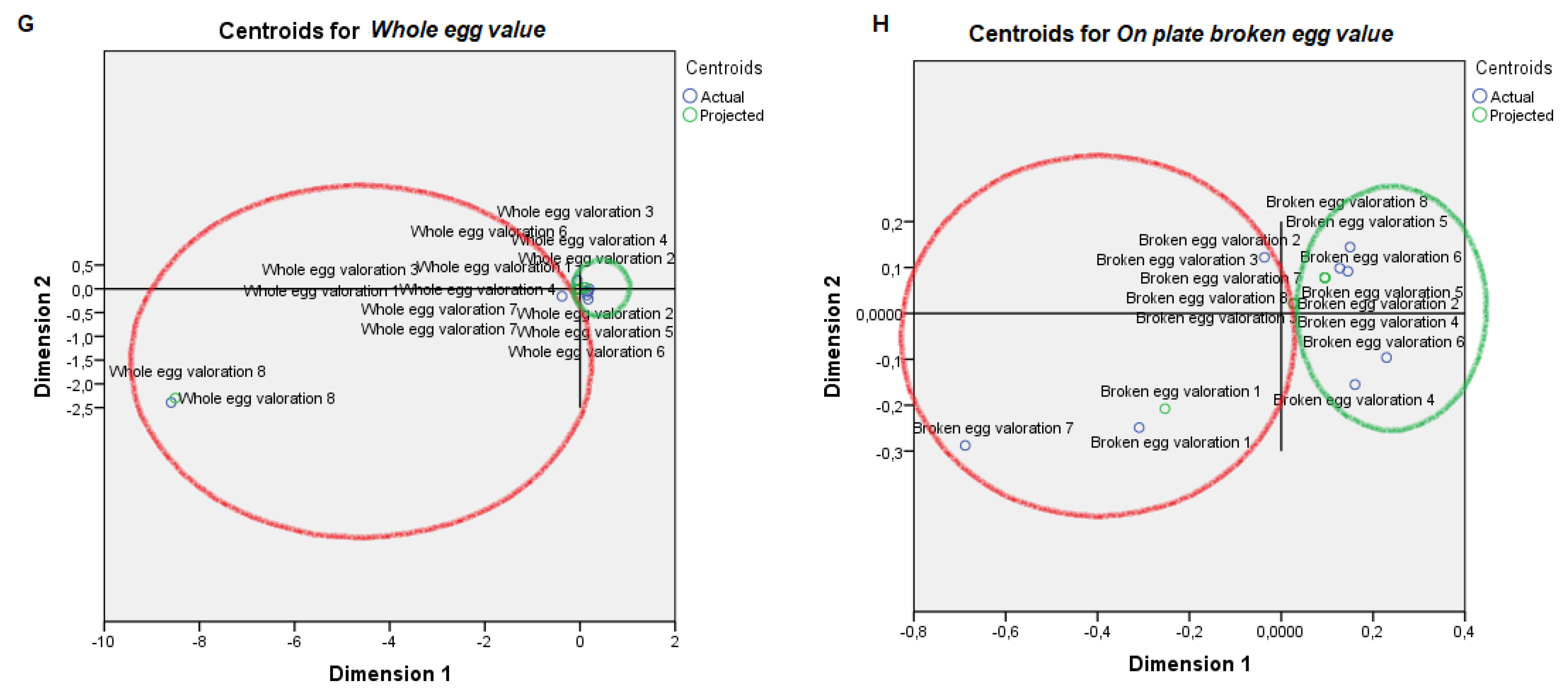
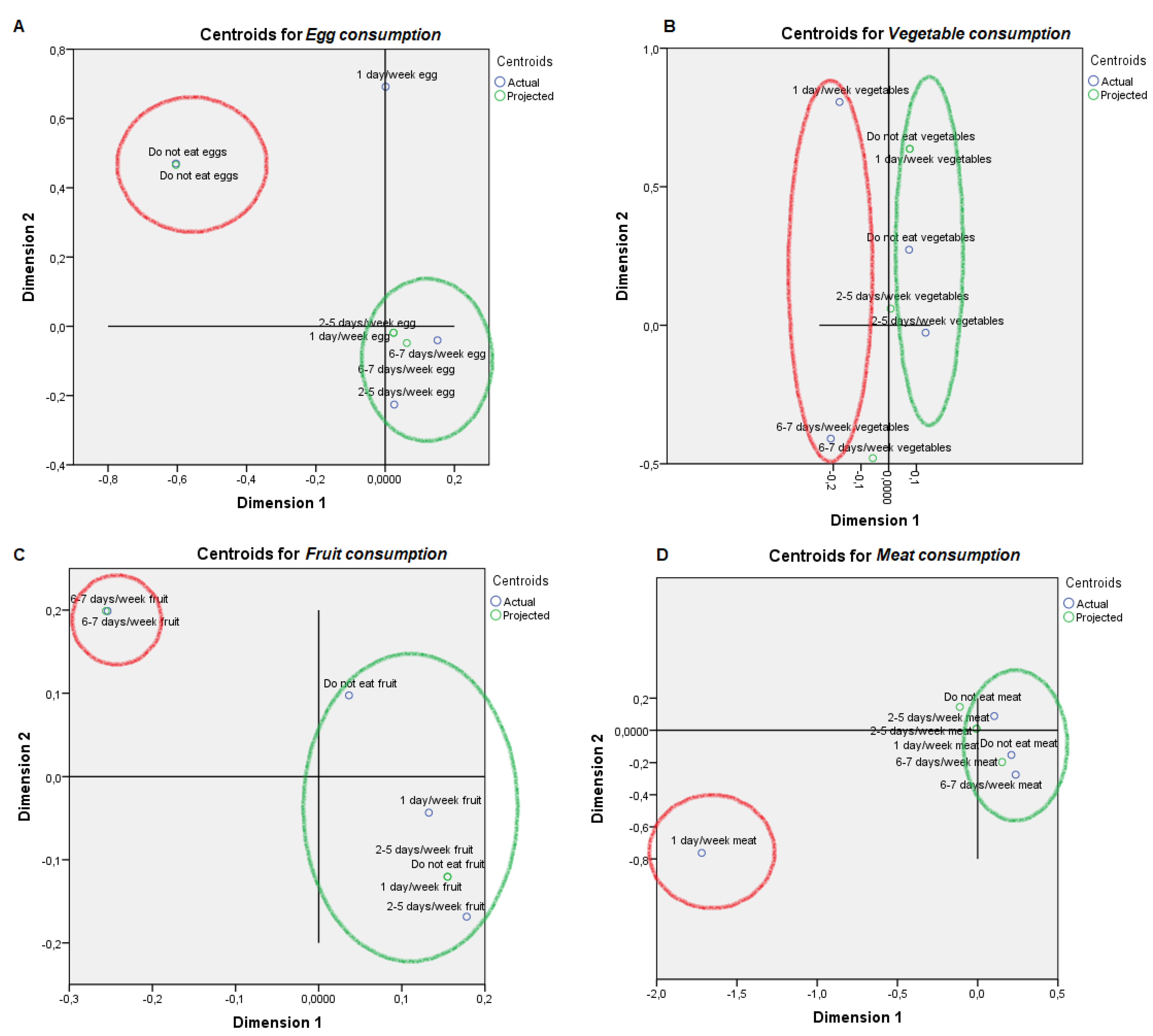
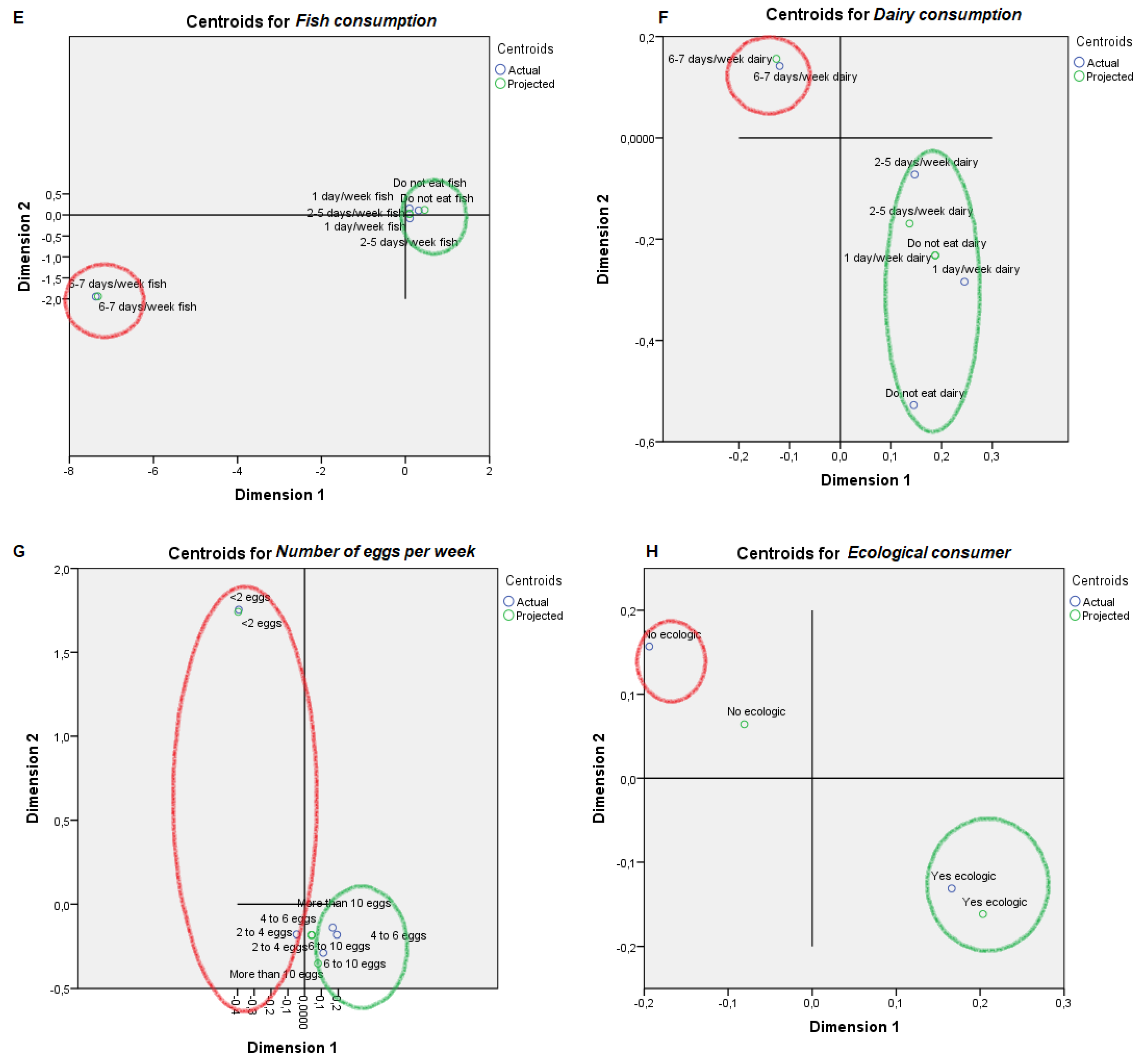
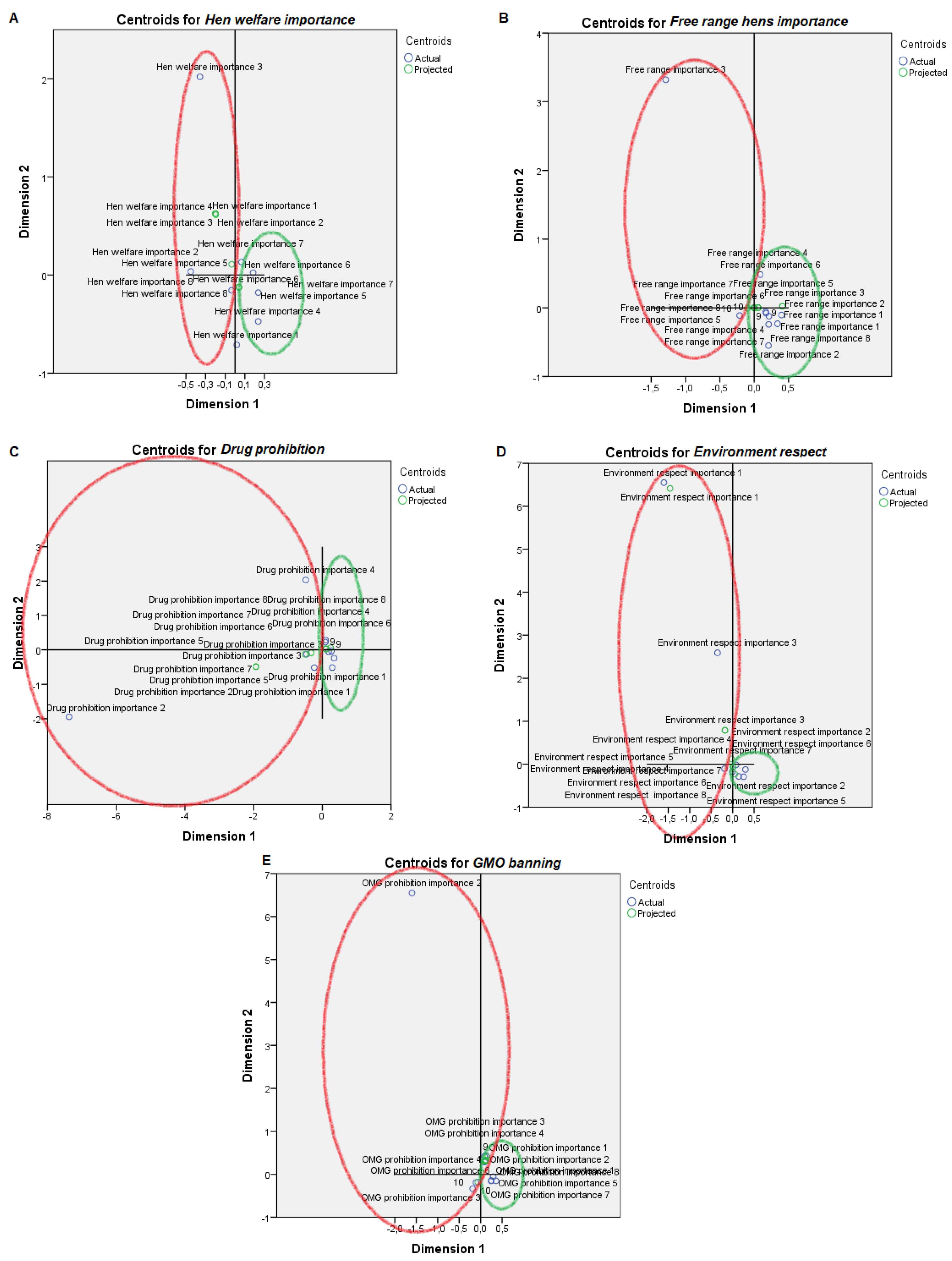
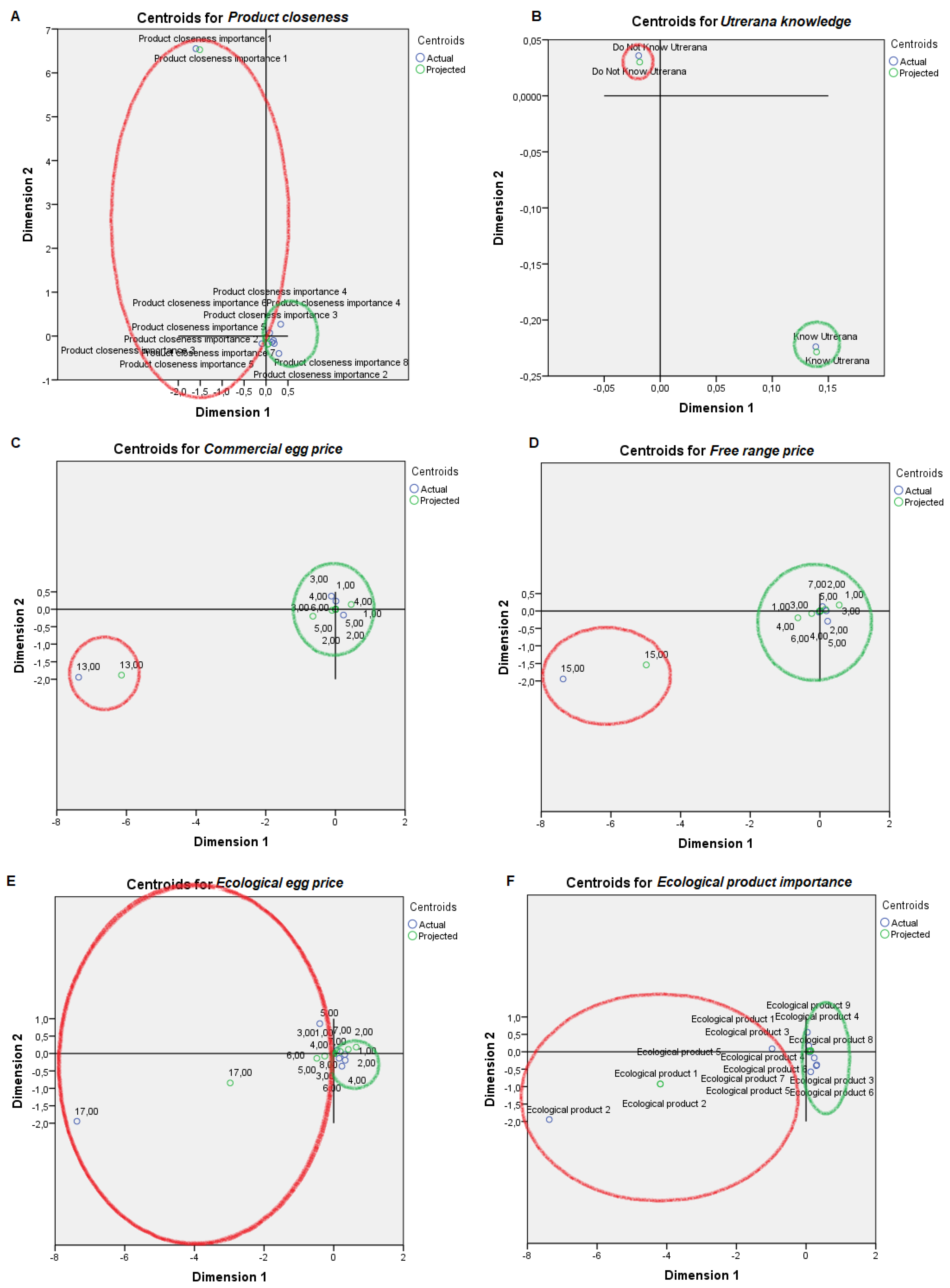
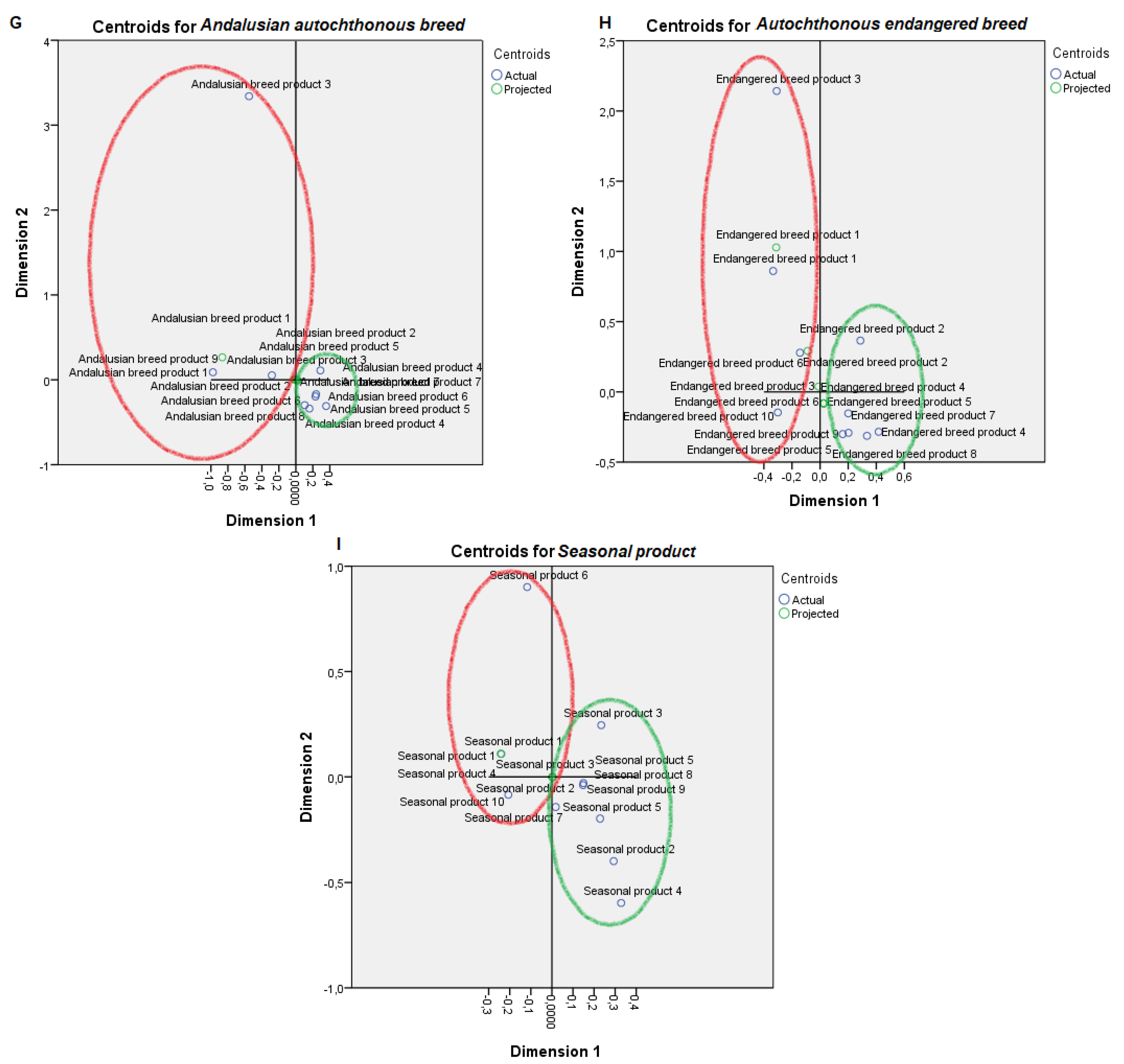
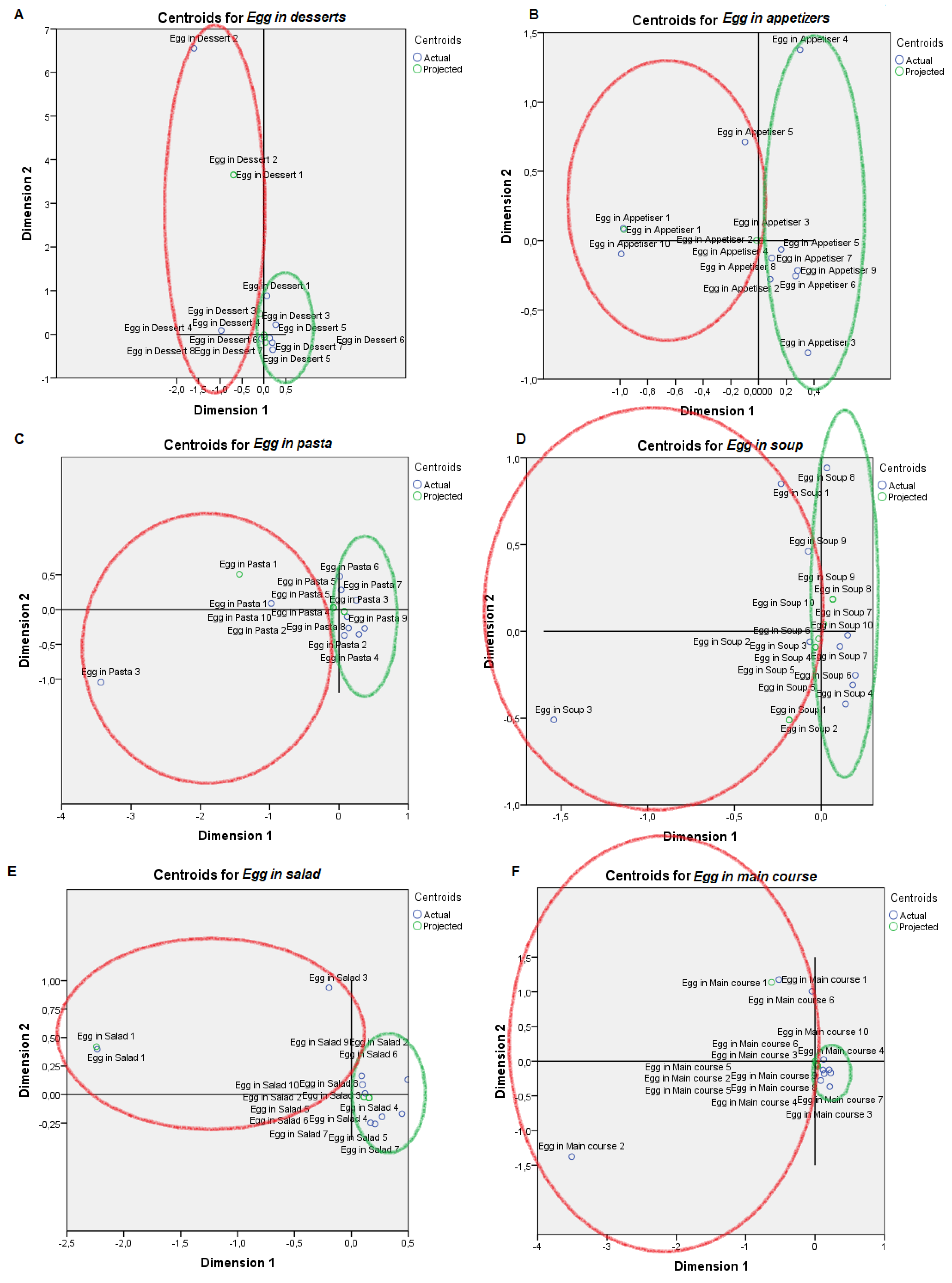
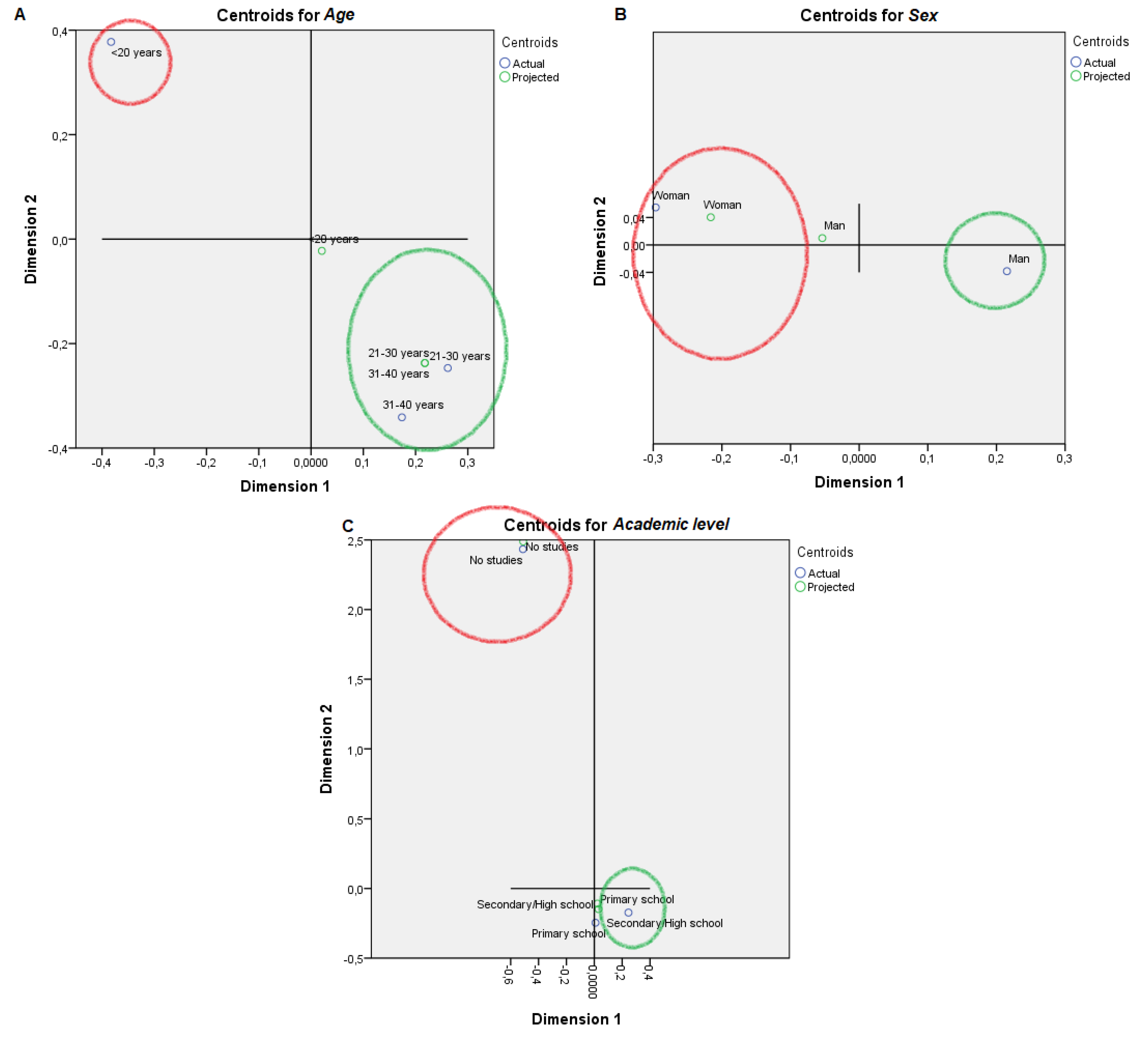
| Egg Type | Cronbach’s Alpha | ||||||
|---|---|---|---|---|---|---|---|
| Commercial | 0.800 | ||||||
| Utrerana | 0.826 | ||||||
| Ecologic | 0.829 | ||||||
| Egg type | Measure type | Intraclass Correlation | 95% Confidence Interval | F Test | df1 | df2 | Significance |
| Commercial | Single | 0.105 | 0.071–0.158 | 5.003 | 63 | 2079 | 0.00 |
| Average | 0.800 | 0.723–0.864 | 5.003 | 63 | 2079 | 0.00 | |
| Utrerana | Single | 0.122 | 0.084–0.180 | 5.733 | 63 | 2079 | 0.00 |
| Average | 0.826 | 0.758–0.882 | 5.733 | 63 | 2079 | 0.00 | |
| Ecologic | Single | 0.125 | 0.086–0.183 | 5.843 | 63 | 2079 | 0.00 |
| Average | 0.829 | 0.763–0.884 | 5.843 | 63 | 2079 | 0.00 | |
| Egg Sensory Attributes | Panelist Diet Habits | Production Context Awareness | Product Consciousness | Cuisine Applicability | Panelist Characterization | Mean | Eigenvalue | |
|---|---|---|---|---|---|---|---|---|
| Dimension 1 | 0.446 | 0.069 | 0.46 | 0.055 | 0.081 | 0.849 | 0.327 | 0.673 |
| Dimension 2 | 0.816 | 0.266 | 0.212 | 0.159 | 0.214 | 0.465 | 0.355 | 0.645 |
| FIT | 1.262 | 0.335 | 0.672 | 0.213 | 0.294 | 1.315 | 0.682 | 1.318 |
| Set. | Variables | Categories | Multiple Fit | Single Fit | Single Loss | ||||||
|---|---|---|---|---|---|---|---|---|---|---|---|
| Dimension 1 | Dimension 2 | Sum | Dimension 1 | Dimension 2 | Sum | Dimension 1 | Dimension 2 | Sum | |||
| Egg sensory attributes | Yolk color | 8 | 0.060 | 0.015 | 0.074 | 0.052 | 0.013 | 0.065 | 0.007 | 0.002 | 0.009 |
| White color | 7 | 0.078 | 0.026 | 0.105 | 0.077 | 0.019 | 0.096 | 0.002 | 0.007 | 0.008 | |
| Odor | 8 | 0.088 | 0.022 | 0.110 | 0.085 | 0.005 | 0.090 | 0.003 | 0.017 | 0.021 | |
| Flavor | 8 | 0.048 | 0.030 | 0.078 | 0.039 | 0.024 | 0.062 | 0.009 | 0.006 | 0.015 | |
| Texture | 8 | 0.045 | 0.095 | 0.140 | 0.032 | 0.093 | 0.126 | 0.013 | 0.002 | 0.015 | |
| Overall value | 8 | 0.009 | 0.099 | 0.107 | 0.005 | 0.097 | 0.103 | 0.004 | 0.001 | 0.005 | |
| Whole egg visual value | 8 | 0.311 | 0.068 | 0.379 | 0.302 | 0.047 | 0.349 | 0.010 | 0.021 | 0.030 | |
| On plate broken egg visual value | 8 | 0.017 | 0.042 | 0.059 | 0.012 | 0.041 | 0.053 | 0.005 | 0.002 | 0.006 | |
| Panelist diet habits | Egg consumption | 4 | 0.002 | 0.162 | 0.164 | 0.002 | 0.161 | 0.163 | 0.000 | 0.001 | 0.001 |
| Vegetable consumption | 4 | 0.032 | 0.254 | 0.286 | 0.032 | 0.249 | 0.281 | 0.000 | 0.005 | 0.005 | |
| Fruit consumption | 4 | 0.014 | 0.134 | 0.148 | 0.013 | 0.132 | 0.145 | 0.001 | 0.002 | 0.003 | |
| Meat consumption | 4 | 0.005 | 0.017 | 0.022 | 0.005 | 0.016 | 0.021 | 0.001 | 0.001 | 0.001 | |
| Fish consumption | 4 | 0.906 | 0.067 | 0.974 | 0.906 | 0.055 | 0.961 | 0.001 | 0.012 | 0.013 | |
| Dairy consumption | 4 | 0.006 | 0.116 | 0.122 | 0.004 | 0.101 | 0.105 | 0.002 | 0.015 | 0.017 | |
| Number of eggs per week | 5 | 0.022 | 0.525 | 0.547 | 0.021 | 0.524 | 0.545 | 0.001 | 0.001 | 0.002 | |
| Ecological consumer | 2 | 0.000 | 0.006 | 0.007 | 0.000 | 0.006 | 0.007 | 0.000 | 0.000 | 0.000 | |
| Production context awareness | Hen welfare | 8 | 0.040 | 0.025 | 0.065 | 0.003 | 0.008 | 0.011 | 0.038 | 0.017 | 0.054 |
| Free range hens | 10 | 0.230 | 0.026 | 0.256 | 0.216 | 0.001 | 0.217 | 0.014 | 0.025 | 0.039 | |
| Drug prohibition | 10 | 0.985 | 0.108 | 1.093 | 0.644 | 0.073 | 0.717 | 0.341 | 0.035 | 0.376 | |
| Environment respect | 8 | 0.069 | 0.854 | 0.923 | 0.036 | 0.798 | 0.834 | 0.033 | 0.056 | 0.089 | |
| GMO banning | 10 | 0.048 | 0.024 | 0.072 | 0.045 | 0.012 | 0.058 | 0.002 | 0.012 | 0.014 | |
| Product consciousness | Product closeness | 8 | 0.055 | 0.676 | 0.732 | 0.055 | 0.674 | 0.729 | 0.001 | 0.003 | 0.003 |
| Utrerana knowledge | 2 | 0.000 | 0.002 | 0.002 | 0.000 | 0.002 | 0.002 | 0.000 | 0.000 | 0.000 | |
| Commercial egg price | 13 | 0.021 | 0.051 | 0.072 | 0.020 | 0.050 | 0.071 | 0.001 | 0.001 | 0.001 | |
| Free range egg price | 15 | 0.002 | 0.051 | 0.052 | 0.001 | 0.051 | 0.052 | 0.000 | 0.000 | 0.001 | |
| Ecological egg price | 17 | 0.002 | 0.025 | 0.027 | 0.000 | 0.001 | 0.001 | 0.002 | 0.024 | 0.026 | |
| Ecological product | 9 | 2.097 | 0.080 | 2.177 | 2.094 | 0.056 | 2.150 | 0.002 | 0.024 | 0.027 | |
| Andalusian autochthonous breed product | 9 | 0.803 | 0.009 | 0.812 | 0.803 | 0.001 | 0.804 | 0.000 | 0.008 | 0.009 | |
| Endangered breed product | 10 | 0.011 | 0.140 | 0.150 | 0.008 | 0.127 | 0.135 | 0.003 | 0.013 | 0.016 | |
| Seasonal product | 10 | 0.004 | 0.019 | 0.023 | 0.001 | 0.001 | 0.002 | 0.004 | 0.018 | 0.021 | |
| Cuisine applicability | Desserts | 8 | 0.039 | 0.641 | 0.679 | 0.023 | 0.526 | 0.548 | 0.016 | 0.115 | 0.131 |
| Appetizers | 10 | 0.017 | 0.340 | 0.357 | 0.002 | 0.313 | 0.315 | 0.015 | 0.027 | 0.042 | |
| Pasta | 10 | 0.032 | 0.222 | 0.253 | 0.021 | 0.213 | 0.234 | 0.010 | 0.009 | 0.019 | |
| Soup | 10 | 0.011 | 0.247 | 0.258 | 0.006 | 0.242 | 0.248 | 0.006 | 0.005 | 0.011 | |
| Salad | 10 | 3.594 | 0.255 | 3.849 | 3.585 | 0.215 | 3.800 | 0.009 | 0.040 | 0.049 | |
| Main course | 10 | 2.323 | 0.924 | 3.247 | 2.319 | 0.904 | 3.223 | 0.004 | 0.020 | 0.024 | |
| Panelist characterization | Age | 3 | 0.193 | 0.046 | 0.239 | 0.192 | 0.046 | 0.239 | 0.000 | 0.000 | 0.000 |
| Sex | 2 | 0.183 | 0.012 | 0.195 | 0.183 | 0.012 | 0.195 | 0.000 | 0.000 | 0.000 | |
| Academic level | 3 | 0.015 | 0.475 | 0.490 | 0.008 | 0.475 | 0.483 | 0.007 | 0.000 | 0.007 | |
© 2019 by the authors. Licensee MDPI, Basel, Switzerland. This article is an open access article distributed under the terms and conditions of the Creative Commons Attribution (CC BY) license (http://creativecommons.org/licenses/by/4.0/).
Share and Cite
González Ariza, A.; Arando Arbulu, A.; Navas González, F.J.; Ruíz Morales, F.d.A.; León Jurado, J.M.; Barba Capote, C.J.; Camacho Vallejo, M.E. Sensory Preference and Professional Profile Affinity Definition of Endangered Native Breed Eggs Compared to Commercial Laying Lineages’ Eggs. Animals 2019, 9, 920. https://doi.org/10.3390/ani9110920
González Ariza A, Arando Arbulu A, Navas González FJ, Ruíz Morales FdA, León Jurado JM, Barba Capote CJ, Camacho Vallejo ME. Sensory Preference and Professional Profile Affinity Definition of Endangered Native Breed Eggs Compared to Commercial Laying Lineages’ Eggs. Animals. 2019; 9(11):920. https://doi.org/10.3390/ani9110920
Chicago/Turabian StyleGonzález Ariza, Antonio, Ander Arando Arbulu, Francisco Javier Navas González, Francisco de Asís Ruíz Morales, José Manuel León Jurado, Cecilio José Barba Capote, and María Esperanza Camacho Vallejo. 2019. "Sensory Preference and Professional Profile Affinity Definition of Endangered Native Breed Eggs Compared to Commercial Laying Lineages’ Eggs" Animals 9, no. 11: 920. https://doi.org/10.3390/ani9110920
APA StyleGonzález Ariza, A., Arando Arbulu, A., Navas González, F. J., Ruíz Morales, F. d. A., León Jurado, J. M., Barba Capote, C. J., & Camacho Vallejo, M. E. (2019). Sensory Preference and Professional Profile Affinity Definition of Endangered Native Breed Eggs Compared to Commercial Laying Lineages’ Eggs. Animals, 9(11), 920. https://doi.org/10.3390/ani9110920






